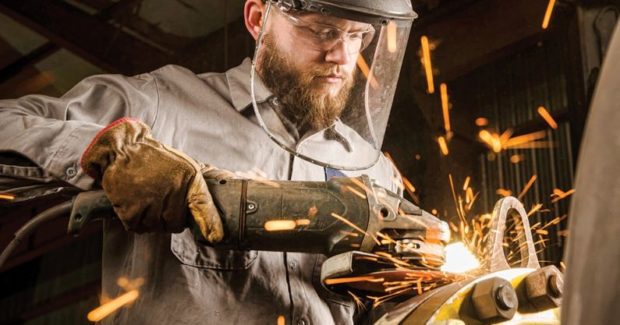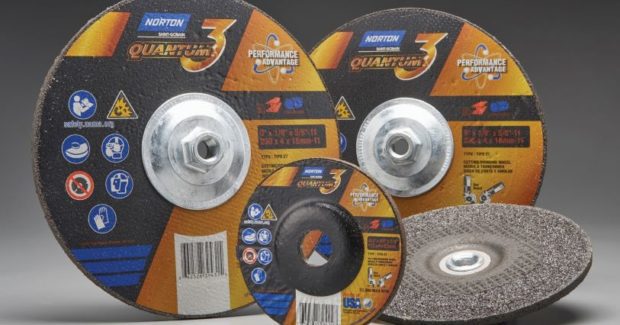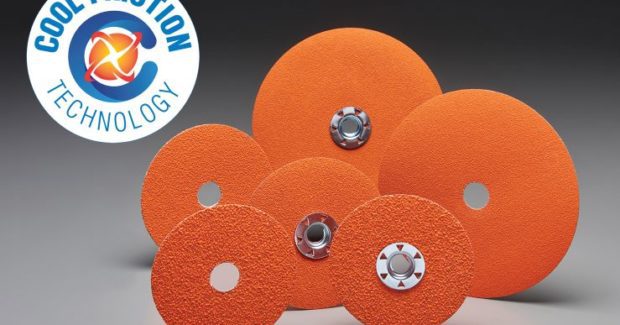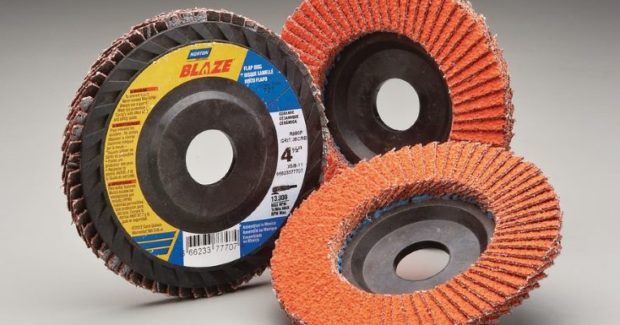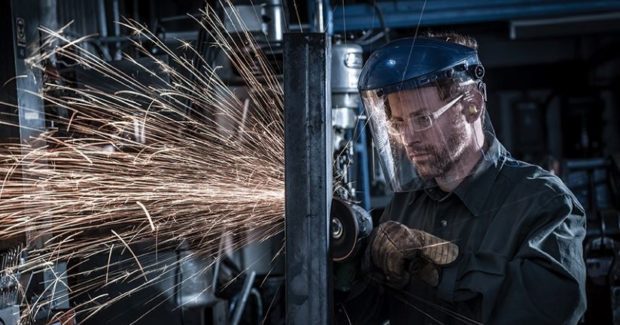Right Angle Grinding Abrasives: Know Your Options
Grinding wheels, flap discs and fiber discs require a great deal of care and storage to ensure safe use of these abrasive products. Never use a damaged wheel or disc. When stored correctly and used properly, wearing the correct PPE, wheels and discs assist in building, repairing and creating many of the objects around us.
Posted: September 12, 2021
SURFACE CONDITIONING COLUMN
By Jeremy Spencer
Operators have choices when selecting an abrasives product to grind down welds or to perform beveling on a workpiece. Choices include grinding wheels, flap discs, or fiber discs. All three excel at removing large amounts of metal. But, what unique advantages can these abrasive products provide?
Let’s start with grinding wheels, the roughest and toughest of the three. They are created by combining resins, fillers, and grain together into a mix and forming the wheel using pressure, time and heat. Once cured, the wheels are extremely hard and can handle the most aggressive grinding applications.
Flap discs are made out of cloth backing and abrasive material. Most of the material used for flap discs can be also used for belts, quick-change discs, and other shaped products. The material is slit and cut into small pieces called flaps. These flaps are held in place by adhesive, pressed onto the backing plate, then cured to set the adhesive forming their shape. Flap discs primarily have two types of backing plates, fiberglass or plastic. Fiberglass is more rigid and less flexible than plastic. If the job is more demanding, fiberglass will be able to remove more material faster. Most plastic backing plates are trimmable to help increase the life and offer additional conformability. Both backing types for flap discs are available in Type 27 wheels which are used at angles from 0-to-15 degrees, and fiberglass backing is used in Type 29 wheels from 15-to-25 degrees.
Fiber discs are also made with abrasives, but the backing is vulcanized reinforced paper. They are strong enough to handle a resin-over-resin coating system, and they are also able to withstand heat generated during grinding.
Grinding wheels and flap discs do not require a back-up pad like their cousin, the fiber disc. Fiber discs require a back-up pad because their reinforced fiber backing alone is not strong enough to withstand the forces of grinding. All three products are available with a 5/8”-to-11″ backing plate or hub insert. The benefits of the 5/8”-to-11″ are easy on-and-off operation without the need for tools, which reduces the change out time.
CARE AND STORAGE
Each product requires a great deal of care, including stock rotation, to ensure safe use. Fiber discs must be stored in proper conditions to prevent curl. If the environment has too much humidity, the backing will absorb the moisture, causing a sand-side in curl. Too little humidity and the backing becomes dry and starts to shrink, producing a sand-side out curl. The sand-side out curl will make it difficult to lock the fiber discs onto the back-up pad and the product could be too dry which may possibly result in breakage. The sand-side in curl will make the edges of the discs more easily able to snag the workpiece, leading to damage or operator injury.
Grinding wheels also need to be stored properly. They should be kept in an area that is not exposed to high humidity or freezing temperatures and they should be kept away from areas that are vulnerable to water or other solvents, because these extremes can affect the bond of the wheel. Most wheels need to be stored in their original container. When the abrasive wheel is mounted on the grinder, it is best to have a holder that can help prevent the wheel from potential damage. If the grinder is dropped, placed on a surface with excessive force or is impacted by other objects, the holder helps protect the wheel from damage. Always inspect wheels before grinding and discard any wheel with cracks or damage.
Flap disc storage is recommended at 40-to-50 percent humidity and 60-to-80 degrees Fahrenheit. It is best to store flap discs in their original container and rotate stock as you would with grinding wheels and fiber discs. Inspect the discs before using and discard if any flaps are missing.
Using all three products requires proper personal protective equipment (PPE) and a clean work area free of bystanders and flammable material.
USAGE
Grinding wheels are extremely tough, but damage can result when a wheel is dropped on a table or hard surface. Care should always be taken to prevent the wheel from becoming damaged, and if a wheel is compromised, it should not be used. By using a damaged wheel at 10,000 rpm, everyone in the room becomes susceptible to a potential accident waiting to happen.
It should also be noted that grinding wheels require more training than flap and fiber discs. A Type 27 grinding wheel requires a 30-degree angle while Types 28/29 require 0-to-15 degrees. Operators that use a Type 27 wheel too flat can increase the bevel, which generates heat and leads to wheel failure. Apply too much of an angle and the wheel will likely start spalling, which means it will break down prematurely. Grinding wheels can be hard to handle because they remove large cutting fragments from the workpiece, and the noise level is greater than its counterparts.
Flap discs also require proper care to maintain their integrity. The flaps that makeup a flap disc are held down with strong adhesive, but that does not make the discs indestructible. If used improperly, such as at excessive angles, or jabbing the discs into tight places, or on an extremely sharp or rough work piece, the flaps could potentially come apart during use. Further, without proper PPE, the operator or others in the area could get hurt. Flap discs require slightly more pressure than fiber discs to wear away the cloth backing to expose more sharp grain. Most operators leave plenty of life on used flap discs instead of applying enough pressure to wear away the cloth backing. Also, insufficient force will cause “capping”, preventing full use of the product. Capping is when metal adheres to the abrasive grain due to excessive heat and insufficient pressure. This can prevent the grain from fracturing which is needed so it can re-sharpen itself.
Fiber discs require less force to do the same amount of work as grinding wheels or flap discs. The required back-up pad provides a strong backing, similar to flap discs. However, the coating method on the paper allows for an aggressive cut similar to grinding wheels. Most operators prefer the higher cut-rate, lower tool vibration, noise reduction, and ease of use of fiber discs compared to grinding wheels. Fiber discs must be used correctly and with proper PPE. Back-up pads must be in good condition and must be made to be back-up pads. Using old fiber discs or cutoff wheels as back-up pads is dangerous and should not be attempted. Discs that have extreme curl should not be used because they can snag the workpiece, or become too brittle and break while under force. Fiber discs may not have the life of flap discs and grinding wheels, but the lower price point and versatility make them an operator favorite.
As mentioned previously, all three products are safe to use if stored correctly and used properly while wearing the correct PPE. Millions of these products are used safely to build, repair, and create many of the objects around us. While these products are safe when used correctly, it is important to remember never to use a damaged wheel or disc. Damaged wheels or discs should be disposed of immediately and a new one should be fitted for operation.
LIFE AND CUT-RATE
In a test, welds measuring 2″ × ½” × ¼” were created by a robotic welder, and removed using a grinding wheel, flap disc, and fiber disc. The test results were as follows:
- Grinding Wheel: First used for removing the weld was the grinding wheel with high quality ceramic abrasive grain. It only took 25 seconds to remove the weld.
- Flap Disc: Next was a ceramic 36 grit flap disc with a fiberglass back plate. It also only took 25 seconds, comparing nicely to the grinding wheel.
- Fiber Disc: The ceramic 36 grit fiber disc was tested last, and it had something to prove. It removed the same amount of weld as both the grinding wheel and flap disc, but it only took 17 seconds at lower amps to get the job done.
If the test was extended to grind for a longer period of time, or if a much larger weld was present, the fiber disc would lose its cut-rate, depending on force and type of metal, in approximately 10-to-14 minutes. Flap discs will continue to wear away and expose new grain, allowing them to last longer than a fiber disc, but their life would be approximately one hour, again depending on force and metal type. The grinding wheel is a long-distance runner and can last longer than flap discs and fiber discs, while doing the same amount of work. Grinding wheels cost more per unit, but if it takes two flap discs or five fiber discs to do the same job, the total cost might be greater using those, not to mention the time it takes the operator to change the discs.
Here are some additional tips:
- When working on a thick weld on a long I-beam or any large piece of metal, a grinding wheel should be the first abrasive product choice.
- Removing or blending regular size welds can be done easily with fiber discs or flap discs.
- Grinding wheels are preferred when metal removal is your only objective, but will not be an optimal choice if the final desired result is polishing.
- Fiber discs will allow for feathering the area with a soft or medium density back-up pad, at a faster pace.
- Flap discs are more rigid but leave a nicer finish when compared grit-to-grit to a fiber disc.
All three abrasive products have unique advantages and can overlap applications to some extent. Following some basic rules of thumb and consulting with your abrasives supplier for their advice will help you achieve optimal results.





